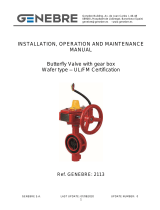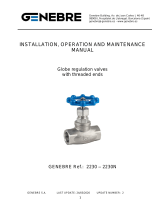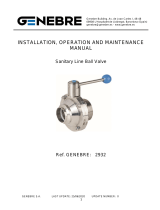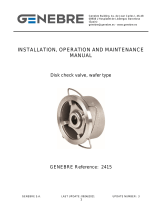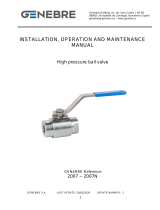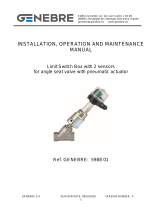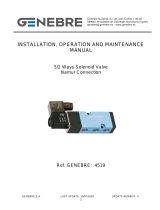Page is loading ...

Genebre Building. Av. de Joan Carles I, 46-48
08908 L'Hospitalet de Llobregat. Barcelona (Spain)
[email protected] - www.genebre.es
GENEBRE S.A.
LAST UPDATE: 23/03/2020 UPDATE NUMBER: 2
1
INSTALLATION, OPERATION AND MAINTENANCE
MANUAL
Wafer butterfly valve
GENEBRE Reference: 2101 - 2104

Genebre Building. Av. de Joan Carles I, 46-48
08908 L'Hospitalet de Llobregat. Barcelona (Spain)
[email protected] - www.genebre.es
GENEBRE S.A.
LAST UPDATE: 23/03/2020 UPDATE NUMBER: 2
2
Installation, operation and maintenance instructions
1) PRODUCT DESCRIPTION ................................................................................... 3
2) VALVE BREAKDOWN ......................................................................................... 3
2.1) DRAWING AND COMPONENTS ................................................................................. 4
3) STORAGE ............................................................................................................... 5
4) INSTALLATION INSTRUCTIONS ...................................................................... 5
4.1) PREPARATION ....................................................................................................... 5
4.2) ASSEMBLING ........................................................................................................ 5
5) OPERATION INSTRUCTIONS ............................................................................ 6
5.1) USAGE ................................................................................................................. 6
5.2) MANUAL OPERATION ............................................................................................ 6
5.3) REMOTE OPERATION ............................................................................................. 7
6) MAINTENANCE OPERATIONS .......................................................................... 7
7) REPAIR INSTRUCTIONS ..................................................................................... 8
7.1) DISASSEMBLING ................................................................................................... 8
7.2) REASSEMBLING .................................................................................................... 8
8) TORQUES ............................................................................................................... 9
8.1) BREAKAWAY TORQUE (N.M) ............................................................................... 10
9) HYGIENE AND SAFETY INSTRUCTIONS ...................................................... 10

Genebre Building. Av. de Joan Carles I, 46-48
08908 L'Hospitalet de Llobregat. Barcelona (Spain)
[email protected] - www.genebre.es
GENEBRE S.A.
LAST UPDATE: 23/03/2020 UPDATE NUMBER: 2
3
1) Product description
Genebre, S.A. offers a wide range of valves (90º turn), designed and assembled to handle
and drive fluids in industrial procedures.
The compatibility of materials used to build the valves (see technical specifications) and the
application of valves to the different industrial processes is at user's risk. Valves will have an
optimal behavior when working conditions do not exceed pressure and temperature limits
(pressure curve) for which they have been designed. Please, refer to the product datasheet.
2) Valve breakdown

Genebre Building. Av. de Joan Carles I, 46-48
08908 L'Hospitalet de Llobregat. Barcelona (Spain)
[email protected] - www.genebre.es
GENEBRE S.A.
LAST UPDATE: 23/03/2020 UPDATE NUMBER: 2
4
2.1) Drawing and components
(Art. 2101)
Nº
Denominación / Name
Material
Acabado Superficial /
Surface Treatment
Cód. Recambio
Spare Part Code
1
Cuerpo Inferior / Downside Body
Fund. nodular / Ductile Iron
EN-GJS-400
Epoxy
------
2
Cuerpo Superior / Upside Body
Fund. nodular / Ductile Iron
EN-GJS-400
Epoxy
------
3
Eje Superior / Upside Stem
Acero Inox. / Stainless Steel AISI 316
------
------
4
Eje Inferior / Downside Stem
Acero Inox. / Stainless Steel AISI 316
------
------
5 *
Asiento / Seat
PTFE c/base EPDM / PTFE on EPDM
------
ET2101
6
Disco / Disc
Acero Inox. / Stainless Steel 1.4408
Pulido / Polished
------
7
Buje / Hub
Nylon
------
------
8
Arandelas Muelle / Spring washer
Acero / Steel
Dacromet
------
9
Tórica / O’ring
Viton
------
------
10
Casquillo / Bush
RPTFE
------
------
11
Arandela / Washer
Acero / Steel
Galvanizado / Galvanized
------
12
Arandela Seeger / Seeger ring
Acero / Steel
Galvanizado / Galvanized
------
13
Maneta / Handle
Aluminio / Aluminium
Epoxy
------
14
Plato / Plate
Acero / Steel
Galvanizado / Galvanized
------
15
Tornillo-Tuerca / Screw-Nut
Acero / Steel
Galvanizado / Galvanized
------
16
Tornillo / Screw
Acero / Steel
Galvanizado / Galvanized
------
(Art. 2104)
Nº
Denominación / Name
Material
Acabado Superficial /
Surface Treatment
Cód. Recambio
Spare Part Code
1
Cuerpo Inferior / Downside Body
Acero Inox. / Stainless Steel 1.4408
Granallado / Shot Blasting
------
2
Cuerpo Superior / Upside Body
Acero Inox. / Stainless Steel 1.4408
Granallado / Shot Blasting
------
3
Eje Superior / Upside Stem
Acero Inox. / Stainless Steel AISI 316
------
------
4
Eje Inferior / Downside Stem
Acero Inox. / Stainless Steel AISI 316
------
------
5 *
Asiento / Seat
PTFE c/base EPDM / PTFE on EPDM
------
ET2104
6
Disco / Disc
Acero Inox. / Stainless Steel 1.4408
Granallado / Shot Blasting
------
7
Buje / Hub
RPTFE
------
------
8
Arandelas Muelle / Spring washer
Acero Inox. / Stainless Steel AISI 301
------
------
9
Tórica / O’ring
Viton
------
------
10
Casquillo / Bush
RPTFE
------
------
11
Arandela / Washer
Acero Inox. / Stainless Steel AISI 304
------
------
12
Arandela Seeger / Seeger ring
Acero Inox. / Stainless Steel AISI 304
------
------
13
Maneta / Handle
Acero Inox. / Stainless Steel AISI 304
Pulido / Polished
------
14
Plato / Plate
Acero Inox. / Stainless Steel AISI 304
Pulido / Polished
------
15
Tornillo-Tuerca / Screw-Nut
Acero Inox. / Stainless Steel AISI 304
------
------
16
Tornillo / Screw
Acero Inox. / Stainless Steel AISI 304
------
------
* Piezas de recambio disponibles / Available spare parts

Genebre Building. Av. de Joan Carles I, 46-48
08908 L'Hospitalet de Llobregat. Barcelona (Spain)
[email protected] - www.genebre.es
GENEBRE S.A.
LAST UPDATE: 23/03/2020 UPDATE NUMBER: 2
5
3) Storage
Manual valves are provided by default in a half-open position whereas automated valves
usually are in a close position due to the standard error position NC (normally closed). During
storage it is recommended to keep them in this same position, with the included protective
wrapping to avoid damages or dirt accumulation. The wrap must not be removed until valve
is to be installed. As far as possible, valves must be stored in a dry and clean environment.
4) Installation instructions
4.1) Preparation
Remove any material remains of the valve wrapping.
Serious problems may arise with the installation of a valve in a dirty pipe.
Make sure the pipe is not dirty and doesn’t have welding particles, for example, before
installing it. This may cause irreparable damages in the valve when the equipment is started
→ prepare a clean working area.
Plan beforehand enough space for future maintenance operations.
Joints between valve and pipe flanges are not necessary, as the elastomer is designed to
keep tightness amongst them.
In case of vibrations in the pipe it is strongly recommended to mount anti-vibration elements
to absorb them. Otherwise, the life of the product could be drastically reduced.
4.2) Assembling
Leave enough space between the
flanges so that valve can be
easily inserted or removed
Fully open the valve before
tightening the screws of the
flanges

Genebre Building. Av. de Joan Carles I, 46-48
08908 L'Hospitalet de Llobregat. Barcelona (Spain)
[email protected] - www.genebre.es
GENEBRE S.A.
LAST UPDATE: 23/03/2020 UPDATE NUMBER: 2
6
REMARKS:
- Wafer butterfly valves by Genebre, S.A. are designed to be assembled between
flanges DIN PN10, DIN PN16 and ANSI 150
- Be extremely cautious when placing the valve in the center of the pipe axis to avoid
interferences between disk and inside part of the pipe. The valve must not be
assembled in any case if the internal diameter of the pipe is lower than the nominal
diameter of the valve
- When assembling with a loose flange and a round pipe (or collar) try to avoid the
weld bead to stand out on the inside part of the pipe because this could damage the
disk and even render the valve inoperative
- Verify good parallelism of the flanges
- Do not install the valve in a completely closed position
- Tighten the screws until the flanges make firm contact with the valve.
- When applying it in mud fluid, place the valve in horizontal position (axis being
parallel to the floor) opening the bottom part of the disk in the direction of the flow to
avoid sediment deposits.
- Valve must never be assembled adjacent to an elbow in order to avoid turbulences.
Minimum distance recommended between elbow and valve is 3 to 5 times the pipe
diameter
5) Operation instructions
5.1) Usage
Butterfly valves provide a leakproof seal when used adjusted to the pressure and
temperature values for which they have been designed.
Seat material for the valve, joints, body, disk and axis has to be fully compatible with the fluid
circulating through the valve. Otherwise, valve could be seriously damaged.
5.2) Manual operation
When operating the valve you must avoid excessive lateral efforts with the handle.
To close it, you must turn the handle 90 degrees clockwise. When the handle is inline with
the pipe, valve is open.
Torques required to operate valves are listed in the table Torque to activate the valves, on
page 9.

Genebre Building. Av. de Joan Carles I, 46-48
08908 L'Hospitalet de Llobregat. Barcelona (Spain)
[email protected] - www.genebre.es
GENEBRE S.A.
LAST UPDATE: 23/03/2020 UPDATE NUMBER: 2
7
For the valves operated with gear box (or gear operator), the quantity of turns to be done for
a complete operation cycle of the 90 degree valve will be conditioned by the transmission
ratio of the gear box. See following table:
Art. 2101
Transmision Ratio
Nr. of handwheel turns (90º)
2” - 5” (+ art. 5975)
24:1
6
6”
24:1
6
8”
30:1
11,25
Art. 2104
Transmision Ratio
Nr. of handwheel turns (90º)
2” - 5” (+ art. 5984 04)
40:1
10
6”
37:1
9,25
8”
45:1
11,25
5.3) Remote operation
When automation of butterfly valves is required, GENEBRE S.A. can provide a great variety
of pneumatic actuators, electric actuators, pneumatic positioners and electropneumatic ones
to cover a large range of operations.
6) Maintenance operations
It is recommended to operate the valve at least once a month.
Elastic-seat butterfly valves are designed so that they do not need any lubrication and/or
periodical maintenance during their life cycle.
However, periodical checks explained below will be useful to extend the service life of the
valve and reduce installation problems:
- Close the valve –from position completely open to completely closed.
- Verify all locks and threaded ends to check if they are loose or with rust. Tighten them if
necessary.
- Inspect the valve and surrounding areas to verify if there is any leakage in the stem or in the
flange connections.
- For an automated valve, verify pipe connections and/or electrical connections of actuators
to check if they are loose due to operation or vibrations.

Genebre Building. Av. de Joan Carles I, 46-48
08908 L'Hospitalet de Llobregat. Barcelona (Spain)
[email protected] - www.genebre.es
GENEBRE S.A.
LAST UPDATE: 23/03/2020 UPDATE NUMBER: 2
8
7) Repair instructions
In case the fluid continues to circulate through the line once the valve is completely closed,
the leakage may be caused by damages in the seat and/or the locking surface, so it will be
necessary to disassemble the valve so that it can be repaired. In this particular case,
GENEBRE, S.A. have different replacement seats or elastomers (part. 3). However, due to
financial reasons, it is not recommended to repair the valve but directly replace it.
7.1) Disassembling
You must remove the valve from installation to repair it.
Prepare a clean working area and adequate tools to perform mechanical tasks.
a.- Close the valve. Loosen and extract the screws or bolts from the flanges. Be careful not to
drop the valve. Help yourself with a fastening element if necessary. Place the valve in a valid
clamp.
b.- Remove the lever (part. 13) and plate (part. 14) or the gear operator or the actuator.
c.- Before the body is disassembled, mark the body halves, is important to reassemble the
body halves in their original position.
Unscrew both body bolts (part. 16) alternately because the body are spring loaded for the
spring washer (part. 8).
d.- When remove the boy parts pay attention not to lose spring washer (part. 8) or packing
(part. 7).
Remove assembled Seat (part. 5) – Disc (part. 6).
e.- Gently bang the disk (part. 6) on its central part with a rubber mallet or similar tool until it
comes off the inside part of the seat (part. 5). Avoid banging the whole perimeter of the disk
because even a small scratch could cause leakage.
7.2) Reassembling
Before proceeding to reassemble the valve, make sure that repair kit and/or pieces to be
used are appropriate and original from the factory.
When it is armored again, cleaning is essential for a long life for the valve.
a.- Please stand the top body half (part. 2) on the top flange upside down and hold.

Genebre Building. Av. de Joan Carles I, 46-48
08908 L'Hospitalet de Llobregat. Barcelona (Spain)
[email protected] - www.genebre.es
GENEBRE S.A.
LAST UPDATE: 23/03/2020 UPDATE NUMBER: 2
9
b.- Put the spring washers (part. 8) according to the Figure A in the up stem (part. 3) of the
valve and after put the packing.
c.- Replace the Disc (part. 6) in its working position within the seat (part. 5) proving it has not
been damaged during the disassembly process and aligning the holes in the disc with the
holes in the seat.
d.- Put the whole disc / seat in the upper body by matching the square of the disk housing
with the valve axis.
e. - Put in the other opening round of the whole disc / seat lower shaft (part 4) ensuring that it
reaches the bottom of the housing of the disk (part 6), place gasket ring (part 7) in the lower
shaft until it contacts the seat (part 5), subsequently placing the spring washers (part. 8) as
shown in Figure B in the bottom of the valve axis.
f. - Place the lower body (part 1) in all pre-assembled, matching the marks previously made
in the body parts to keep its original position.
g. - Place the side screws (part 16) and alternately set to leave about a 3 mm on both sides
of marriage, place the disc in the closed position and finish side tighten the screws until
metal-metal contact between the two parts of the body.
h. - After the final adjustment of the side screws to open the valve to verify that the operating
Figure A
Figure B

Genebre Building. Av. de Joan Carles I, 46-48
08908 L'Hospitalet de Llobregat. Barcelona (Spain)
[email protected] - www.genebre.es
GENEBRE S.A.
LAST UPDATE: 23/03/2020 UPDATE NUMBER: 2
10
torque responds to those shown in Table 7.1.
i. - Finish by placing the handle, steering gear or actuator as appropriate, given its open or
closed position.
j. - Reinstall the valve between flanges. See Installation Instructions page. 4.
8) Torques
8.1) Breakaway torque (N.m)
DN
50
65
80
100
125
150
200
Torque
N·m
25
30
35
65
110
200
300
9) Hygiene and Safety Instructions:
9.1) Fluids that go through the valve can be corrosive, toxic, flammable or pollutant. They can
also be found at very high or low temperature. When operating valves, you must follow the
security instructions and it is recommended to use personal protection gadgets:
1) Protect your eyes.
2) Wear gloves and appropriate working clothes.
3) Wear safety footwear.
4) Wear a helmet.
5) Have running water at hand.
6) To operate flammable fluids, make sure you have an extinguisher at hand.
9.2) Before removing a valve from a pipe, check always if the line is completely drained and
depressurized.
9.3) Any valve being used by toxic services department needs to obtain a cleanliness
certificate before being operated.
9.4) Any type of repair or maintenance should be performed in ventilated places.
/
